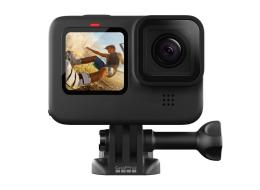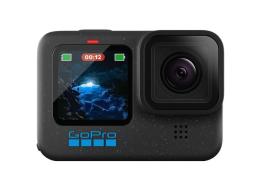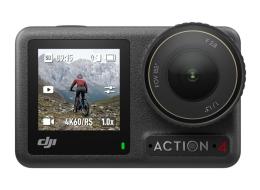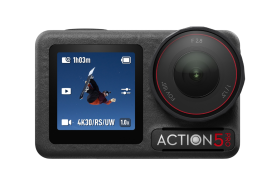Understanding Action Camera Specs: Color Profiles and Bit Depth


Action cams not only capture how much light, but also how color and tone are recorded. This is where color profiles and bit depth come into play. These specs matter when you care about how vibrant or flexible your footage’s colors are, especially if you plan to edit or color-grade your videos.
Color Profiles
Most action cams offer at least two main color modes: a standard default (often called “Vivid” or just the camera’s default color) and a Flat or Log profile for more advanced users. The standard profile is tuned to look punchy and nice straight out of camera – good contrast, saturated colors, ready to share. The flat or log profile (logarithmic curve) looks dull and desaturated out of camera on purpose.
Why? Because it preserves more dynamic range and doesn’t “bake in” a heavy look, giving you more flexibility to adjust colors and contrast in post-production (color grading). It’s akin to shooting photos in RAW vs JPEG: the flat profile is like a RAW that looks washed out but retains information, whereas the standard profile is like a processed JPEG – pretty immediately, but with less editing latitude.
For example, GoPro’s older cameras had a Protune Flat color mode; DJI has a D-Cinelike (which is a mildly flat profile); the newest GoPro Hero12 even has something called GP-Log. These flat profiles are great if you intend to do some editing. If you don’t plan on color grading, you might stick to the standard profile for convenience.
Dynamic Range and Profiles
In very contrasty scenes (bright sky, dark shadows), a flat profile will retain more detail in highlights and shadows by not overly boosting contrast. Later, in editing, you can decide how to curve the tones. This is especially useful if you’re mixing footage from the action cam with other cameras in a project and need them to match – you can color grade them all to a unified look.
Bit Depth (8-bit vs 10-bit)
This is a more technical spec referring to how many shades of color the camera can record per channel. An 8-bit image can represent 2^8 = 256 levels for each primary color (red, green, blue), which equates to 16.7 million possible colors in total. A 10-bit image can represent 1024 levels per channel (2^10), totaling about 1.07 billion possible colors. More bits = finer gradations of color.
What does this mean practically? With 8-bit (which was the standard for video for ages), if you try to push the colors around too much in editing, you might see banding – these are those visible “steps” in what should be a smooth gradient (like the sky going from light blue to dark blue might show stripes). 10-bit, with its many extra levels, produces much smoother gradients – banding is far less likely even after color grading. A reviewer explained it succinctly: “10-bit gives each pixel the ability to pick from over 1 billion shades of color, compared to 16 million shades offered by 8-bit. This allows for smoother color gradations and avoids banding.” In effect, 10-bit is a big boon for post-processing.
For a long time, action cams were strictly 8-bit devices (to save processing and file size). But in 2022, GoPro introduced 10-bit color on the Hero11, and DJI followed with 10-bit on its Action 3/4. This was a welcome change for enthusiasts and pros. With 10-bit Log footage from a GoPro, for example, you can now really push the colors – do heavy contrast adjustments, color corrections – with less image degradation. One reviewer noted the Hero11 in 10-bit Log holds more detail in shadows and highlights and is much more gradable than prior 8-bit footage.
That said, if you are just shooting for quick social media posts and not editing much, 10-bit might not visibly change your output. In fact, if you view 10-bit footage without proper color grading, it may look similar to 8-bit. The key difference is when you grade or process the footage, or view it on a high dynamic range display.
Another point: not all modes may support 10-bit (for instance, high-frame-rate modes might be limited to 8-bit to save on data). Check the camera’s specs – e.g., GoPro might disable 10-bit above 60fps or in certain modes.
To the eye
10-bit can capture subtle variations in sunsets, shadows, or water tones that 8-bit might compress into banding. If you do a side-by-side of a heavily color-graded 8-bit vs 10-bit video, you’d notice the 8-bit one might show color banding or break apart in extreme grades, whereas the 10-bit holds together (the sky stays smooth, the color transitions on a sunset or in low-light scenes are more natural).
Typical vs. High-End Example
Typical action cams up to 2021 recorded 8-bit color only, and many users just shot in the default GoPro-color or Vivid mode (which is fine for general use). A high-end 2023 action cam like the GoPro Hero11/Hero12 offers 10-bit color and a Log profile. This is a significant upgrade for those who do editing.
As RedShark review put it, 10-bit is mostly beneficial if you are a “power user” doing color grading; if you only output straight from camera, you might not notice a big difference. But even without grading, some extremely subtle banding in things like gentle fog or a sunrise might be reduced with 10-bit.
DJI’s Osmo Action 4 similarly can record in 10-bit D-Log M or even HLG (a form of HDR). That means these little cameras can now be part of higher-end workflows and even handle HDR video production (with the right settings).
Practice: Check out our action camera index page and try and find two models with complete opposite FOV angle and see how their specs match.
Conclusion
If you’re a beginner, you can leave the camera on the standard color profile and 8-bit and get very nice results. As you advance, experiment with the flat profile and try color grading your footage; you’ll quickly see where 10-bit helps (you can pull the shadows up or change the color tint more aggressively without weird artifacts).
Just remember that 10-bit files will be larger and not all devices or editing apps handle them smoothly (make sure your editing software is up to date). But it’s a great spec to have for “future-proofing” your footage and squeezing the maximum image quality out of that small camera.
Check out part six of the series where we discuss what are aperture, ISO, and noise?
Missed part four? Then go back and learn what's EIS and what is OIS?
Featured image by Sanju Pandita.
Action Cameras with Advanced Color Profiles and Bit Depth Options
FAQ
What is a color profile in action cameras?
A color profile determines how your camera processes color and tone. Most action cams offer a standard profile (vivid and ready-to-share) and a flat/log profile (dull-looking but better for editing and color grading).
Why use a flat or log color profile?
Flat/log profiles preserve more dynamic range, making them ideal for editing. They capture more detail in shadows and highlights, giving you flexibility to shape the final look during color grading.
What’s the difference between 8-bit and 10-bit video?
8-bit video can display 16.7 million colors; 10-bit can show over 1 billion. 10-bit footage allows for smoother color gradients and holds up better during heavy editing, with less risk of color banding.
Is 10-bit video always better?
Yes, if you're editing your footage or using HDR displays. If you're just sharing straight-from-camera clips on social media, you may not notice a major difference—though subtle improvements (like smoother skies or cleaner shadows) can still be present.
When should I use 8-bit vs 10-bit?
Use 8-bit for everyday shooting and quick sharing. Use 10-bit if you're color grading, working on pro projects, or want future-proof footage with maximum image quality.
Do all camera modes support 10-bit?
Not always. Some cameras limit 10-bit in high-frame-rate or special shooting modes to save on processing and file size. Always check your camera’s specs.
Is editing 10-bit footage harder?
Not harder, but it requires more capable software and hardware. 10-bit files are larger and may not play back smoothly on all devices or in older editing apps.




